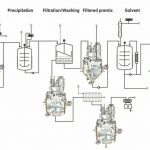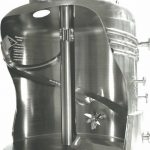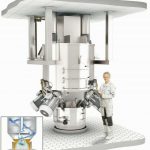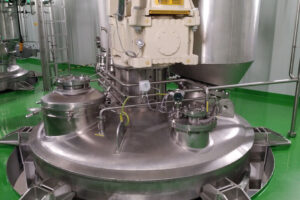The term pesticides groups together substances with different effectiveness levels. These are chemical or biological high-tech active ingredients, which are used against undesirable organisms found in the agriculture sector with the aim of maximising yield.
It takes about ten years of intensive development work, however, before an approved pesticide can be launched on the market. During this period, a manufacturer will invest about 200 million euros, conduct around 200 studies and perform tests using more than 800 parameters.
First of all, a search for suitable substances takes place and pilot projects are tested in the laboratory. Even for these tests, the active ingredients are converted from formulations into products that can be applied in agriculture. For this purpose, so-called carriers – powdered minerals or organic solvents – as well as additives (usually surfactants acting as emulsifiers, wetting or adhesive agents) are used. The job of the coformulants is to make the active ingredients technically safe and usable so that spreading them is safe and their effectiveness is optimal.
Different preparation technologies are then weighed up against each other: for example, micronisation – grinding very finely for a uniform suspension in water and then later safely spraying or dripping it on the crop plants – or encapsulation, which automatically regulates the availability and effect of the substance.
Once all parameters and other attributes relating to the application have been optimised, pilot trials are carried out in the test centre. The aim is to synthesise the active ingredient in a way that makes it pure, stable, highly concentrated and reproducible. This project phase is particularly challenging from a process engineering point of view, because the piloted apparatus must be adequately capable of being scaled up in order to overcome the subsequent mass flows and batch sizes, which are larger by a factor of 20 to 100 as a rule.
Multi-stage production process
The synthesis steps for manufacturing pesticides differ depending on the active ingredient and preferred spreading method. The basic process steps are similar, however, for the basic powdered substances.
First of all, a solvent is placed in the reactor, powdered reagents are added and dissolved or homogeneously suspended. The first reaction step takes place during this liquid phase. The stirring process can be supported by circulation pumps to enhance the reaction kinetics. Once the reaction has completely finished, the new substance is present in liquid form. It is mixed with additives to trigger a crystallisation of the active ingredient, which is promoted by skilful temperature changes. At the moment of the phase transition, a particularly effective mixing effect is necessary – especially when very rapid, even and gentle cooling is required.
The still suspended solids mostly remain capable of being pumped and are now subjected to a multi-stage washing process. The cleaned product is mechanically separated into a solid and liquid phase. Continuously working centrifuges or even filter presses are also used. As a rule, gastight, sealed systems are preferred. Finally, the thermal drying process takes place.
The concluding vacuum drying produces an initial synthesis result, which can act as a starting material for a second synthesis step. Highly effective, modern powdered chemicals are usually the result of several synthesis steps, which nearly always finish with a vacuum mixer drying stage. During the process, the active ingredient becomes more valuable and often more sensitive with each synthesis step. Thermal and mechanical stress must therefore be avoided during drying.
Gentle drying and rapid cooling
If, at any point in the process, the method of production is transferred from batch processing to continuous or vice versa,
the material flow must be collected in buffer tanks. These buffer tanks for damp materials are also called paste bunkers.
Paste bunkers must continue to work perfectly even if the damp materials are thickening or reacting as a dilatant. They must store the goods gastight according to requirements and discharge them as completely as possible. At the same time, paste bunkers should only agitate the mass as little as possible so as to preserve its granulometric characteristics. Sometimes it is even necessary to slightly adjust the temperature of the wet mass.
This is also the case in the manufacture of pesticides. At the end of the filtration process, the product resembles a crumbly, damp bulk material. Actually, it is usually pseudoplastic and its consistency soon changes when it is agitated. It can then become adhesive and sticky.
From the paste bunker, the product takes a short route to the contact dryer installed underneath, which dries the product in batches with gentle continuous flow drying. At this point, all components in contact with the product are heated in the amixon dryer: the entire mixing chamber, the mixer shaft, the mixer arms and the helix. If needed, High Shear Blades deagglomerate the batch or distribute liquid admixtures.
When they enter the mixing-dryer, the wet masses contain around 15 to 40 % liquid by mass. This can be water, solvents or mixtures of the two.
The suspension is dried under vacuum, as the stability of the substance and its subsequent effect must not be impaired by thermal stress. Some active ingredients may not be heated above 35 °C in this respect.
The Amixon vacuum conical mixing-dryers are therefore suitable for rapid, gentle vacuum drying using short cycle times. In the case of vacuum drying, the drying temperature is lowered, because pure water, for example, boils in the drying chamber at just 21 °C when the system pressure reaches 25 mbar.
Ideal mixing tools
The drying time can be reduced if particularly large amounts of heat are introduced into the mixed material and each particle touches the mixer-dryer’s heated surfaces as often as possible. Three-dimensional flow mixing of the products at a low mixer rotational speed is beneficial here, regardless of their rheological changes. It is not rare to have a well-flowing, pumpable suspension at the start, which then turns highly viscous, tough and pasty – like chewing gum – to gradually form large, crumbly lumps. During the course of the drying progress, these disintegrate resulting in a free-flowing active powder with ideal homogeneity. These changes in consistency can only be controlled if the mixing tools are ideally formed.
The thermal fluid is directed to all areas in contact with the product using half-pipe coils or the classic double-shell. This also applies to the rotating mixing tool, whose shaft, mixer arms and helix agitators have internal thermal fluid ducts. The base and top of the mixing chamber are also temperature controlled. Uniform temperature control is particularly challenging when the thermal fluid enters as steam and leaves the apparatus as condensate. The enthalpy change of the thermal fluid then allows the introduction of particularly large amounts of heat into the mixed material.
Special mixer-coolers
After drying, the mixed materials must be cooled before the filling process. Naturally, the cooling process can also take place in the vacuum mixer-dryer. In practice, however, an extra mixer-dryer increases production efficiency. A suitably sized mixer-dryer below the vacuum-dryer can thus considerably increase the output quantity of an installation. It then also takes over the filling of big bags and containers in portions, or also the feeding of automatic filling lines.
In this respect, the cooling of large powder masses in batches is not a simple matter, because:
- The cooling surfaces and dry particles touch each other here and there at best, which does little to support the transfer of heat
- The thermal conductivity of the powders is usually low
- Any stirring/mixing energy introduced increases the temperature of the mixed material, which is actually supposed to be cooled
- The cooling brine used must not be that cold, as condensation is to be prevented
In order to adhere to all these requirements, very large heat exchange surfaces must be available and the mixed materials may only be moved with very little energy – this is where amixon mixer-coolers make full use of their design benefits.
The formulation line
The active ingredients are blended, crushed, mixed, moistened or agglomerated in the so-called formulation line so that the user can apply them safely and evenly. For blending, the part compositions are up to 1:1,000. Besides water-soluble substances, bentonite, kaolin or powdered limestone can be used as carriers. Air separation mills micronise the active substances so finely that they aggregate with the carrier without segregation. The mixing and wetting process is intensified by the Amixon High ShearBlades. The more accurately the intensive mixer mixes and empties, the safer the process.
Achieving ideal mixed materials in a particularly short time is something that precision mixers can do these days in a reproducible manner. If, however, the precision mixer is supposed to empty in just a few seconds, there are hardly any alternatives to the Amixon Koneslid mixer.
The Koneslid mixer is a vertical precision mixer whose mixing tool is only supported and driven at the top. It is ideally adapted to the cylindrical-conical mixing chamber. The special thing about it is the inverted conically shaped displacer inside the cone. This helps the materials to flow without dead spaces during the mixing process and it also ensures the particularly fast complete discharge of the mixed materials when it moves downwards a few centimetres.
Formulation lines are used for small batches. Afterwards the apparatus is thoroughly cleaned with water. The Koneslid mixer even completes this wet cleaning and drying automatically in just a few minutes using fitted orbital jet cleaners at a water pressure of 15 bar. These jets are then controlled with pressurised air for drying purposes. Thanks to several particularly large inspection doors, the Koneslid mixer can be conveniently maintained.
After mixing, the powdered pesticides are packed in small containers so that the user can conveniently dissolve them in suitable water feeds.
Amixon GmbH, Paderborn
Hall 12.0, Booth C21











